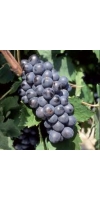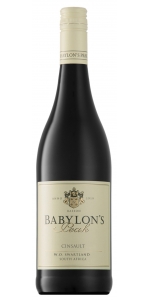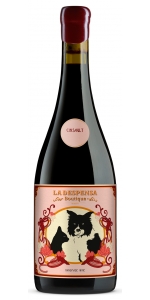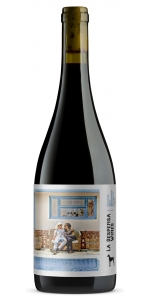Cinsault

Cinsault or Sinsault is a red wine blending grape most commonly grown in Southern France. Cinsault has a dark skin and most often used in Grenache, Syrah, and Mouvedre blends. Cinsault is sometimes produced as its own variety as a Rose, which is airy and crisp with a pleasing nose. In France, Cinsault is allowed to be included in a Chateaneuf du Pape blend. However, in other parts of the world such as Morocco, Algeria, Tusisia, Corsica, and Lebanon, Cinsaut is one of the principal production grapes. It does extremely well in hot and dry climates, and is susceptible to rot in damp environments. Cinsaut is the very first founder of Pinotage in Africa. It was blended with Pinot Noir in 1925. Pinotage now is the majority grape in African vineyards of the Western Cape. Cinsaut produces extremely low tannins, but gives favorable aroma to any blend. Cinsault will give substantial yields of light red berries.
Babylons Peak Cinsault is made from 100 percent Cinsault.
Medium to light bodied. Fruit driven with spicy undertones. Soft tannins and fine complexity. A fruit driven wine with lively light palate and lingering mouthfeel.
Review:
"Savory aromas of black olives, grilled meat, thyme, peppercorns and dark fruit. It’s medium-bodied with fine tannins and a flavorful, succulent and peppery palate. Drink now."
- James Suckling (December 2021), 90 pts
La Despensa Boutique Cinsault is made from 100% Cinsault.
A genuinely unique wine - they are the only producers of Cinsault in Colchagua! From a new vineyard planted in 2017, the team at La Despensa thinks they’ve hit the jackpot with this variety in this valley. Much more structure, color and intensity than the typical Chilean Cinsaults from further south, this is an easy drinking but serious version of this wonderfully fruity variety!
La Despensa Boutique Cinsault is made from 100% Cinsault.
A genuinely unique wine - they are the only producers of Cinsault in Colchagua! From a new vineyard planted in 2017, the team at La Despensa thinks they’ve hit the jackpot with this variety in this valley. Much more structure, color and intensity than the typical Chilean Cinsaults from further south, this is an easy drinking but serious version of this wonderfully fruity variety!
Review:
"Apparently the first and only Cinsault from Colchagua, the 2021 Boutique Cinsault was produced with vines planted in 2017 and worked organically (but is not certified), and it's much darker and more structured than the examples from the south. It fermented in concrete with selected yeasts and went through malolactic in stainless steel and then 60% of the volume matured in used barriques for six months. It has 13.5% alcohol and kept good freshness, and it's varietal, balanced and easy to drink but not banal. 1,200 bottles were filled in March 2022. - Luis Gutiérrez"
- Robert Parker's Wine Advocate (April 2023), 91 pts
La Despensa Boutique Pool Blend 75% Cinsault, 15% Pais, 5% Marsanne and 5% Roussanne.
A genuinely unique wine - La Despensa is the only producer of Cinsault in Colchagua and Pais from this valley is also extremely rare! The Cinsault and the 2 whites come from a new vineyard planted in 2017 and the Pais from a 150 year old, dry-farmed vineyard in Pumanque about 20 minutes from the winery that they run themselves organically. The Cinsault and Pais give notes of raspberry and strawberry and the white Roussanne and Marsanne a little mouthfeel and a hint of tropical fruit.
Organically grown grapes (not certified) from our own vineyard in Santa Ana, and Pumanque in the Colchagua Valley. Irrigated as sparingly as possible via drip irrigation (dry-farming for the 150 year old Pais). Hand harvested and sorted personally by me in the vineyard (I personally check every single bunch), then destemmed with the crusher removed from the destemmer. Grapes are fermented in open top bins and concrete tank and blended immediately after pressing. MLF occurs with the wine already blended. Wines are racked in November and again in January before being bottled after about 10 months ageing in 50% neutral oak barrels and 50% Flextank.
Versatile, goes well with beef, chicken, pasta, great for Summer BBQs
Review:
"The red blend 2021 Wines Pool Blend was produced with an unusual blend, especially for a wine from Colchagua, of 75% Cinsault, 15% País and 5% each Marsanne and Roussanne. It has kept a moderate 13.5% alcohol and retained good freshness (pH 3.44) after maturing exclusively in Flextank and being bottled unoaked. This is fruit-driven and straightforward, with a medium-bodied palate and fine tannins. 2,400 bottles produced. It was bottled in March 2022. - Luis Gutiérrez"
- Robert Parker's Wine Advocate (April 2023), 90 pts
La Despensa Boutique Pool Blend 75% Cinsault, 15% Pais, 5% Marsanne and 5% Roussanne.
A genuinely unique wine - La Despensa is the only producer of Cinsault in Colchagua and Pais from this valley is also extremely rare! The Cinsault and the 2 whites come from a new vineyard planted in 2017 and the Pais from a 150 year old, dry-farmed vineyard in Pumanque about 20 minutes from the winery that they run themselves organically. The Cinsault and Pais give notes of raspberry and strawberry and the white Roussanne and Marsanne a little mouthfeel and a hint of tropical fruit.
Organically grown grapes (not certified) from our own vineyard in Santa Ana, and Pumanque in the Colchagua Valley. Irrigated as sparingly as possible via drip irrigation (dry-farming for the 150 year old Pais). Hand harvested and sorted personally by me in the vineyard (I personally check every single bunch), then destemmed with the crusher removed from the destemmer. Grapes are fermented in open top bins and concrete tank and blended immediately after pressing. MLF occurs with the wine already blended. Wines are racked in November and again in January before being bottled after about 10 months ageing in 50% neutral oak barrels and 50% Flextank.
Versatile, goes well with beef, chicken, pasta, great for Summer BBQs.
- back
Selected Options
Grape Types
Categories
Pricing
Countries
Regions
Grape Types
Wineries
Organic/Free Shipping
An inky purple hue, the wine offers fragrant aromas of ripe, brambly berries and plums, edged in notes of walnut husk and cedar. The palate explodes with intense flavors of redcurrant and cherry, fanning out in a broad, silky wave that mingles vibrant fruit flavors with accents of espresso, chocolate and graphite, and lingers on the long finish.
Review:
A new project from the Indelicato family (Black Stallion Winery) and consultant Thomas Rivers Brown, the 2019 Cabernet Sauvignon is a ripe, full-bodied effort, loaded with scents of cherries, baking spices and dark chocolate accented by subtle herbal shadings. It's supple and expansive on the palate, culminating in a long, mouthwatering finish that combines a touch of warmth and a dusting of silky tannins. It should drink well for more than a decade.
- Robert Parker's Wine Advocate 95 Points
Corinne Perchaud Chablis 1er Cru Fourchaume is made from 100 percent Chardonnay
Elegant citrus aromas. Concentrated and finessed, combining flavors of dried fruit with slight hints of woody notes. Perfect balance between body and acidity, long and persistent finish. This one is drinking great now, but as with all exceptional Chablis, it is possible to pay it down for years to come.
Made from 35 year old vines. The owners take great care to produce exceptional Chablis wine by keeping the lively Chardonnay fruit and the unique mineral quality imparted by the Kimmeridgian soil, the fruity acidity and bouquet in perfect balance. The grapes are harvested by hand and gently pressed in a horizontal pressoir to ensure the fullest extraction and range of flavors and aromas.
Pair with Scallops Jacques cream, roast veal with oyster mushrooms.







